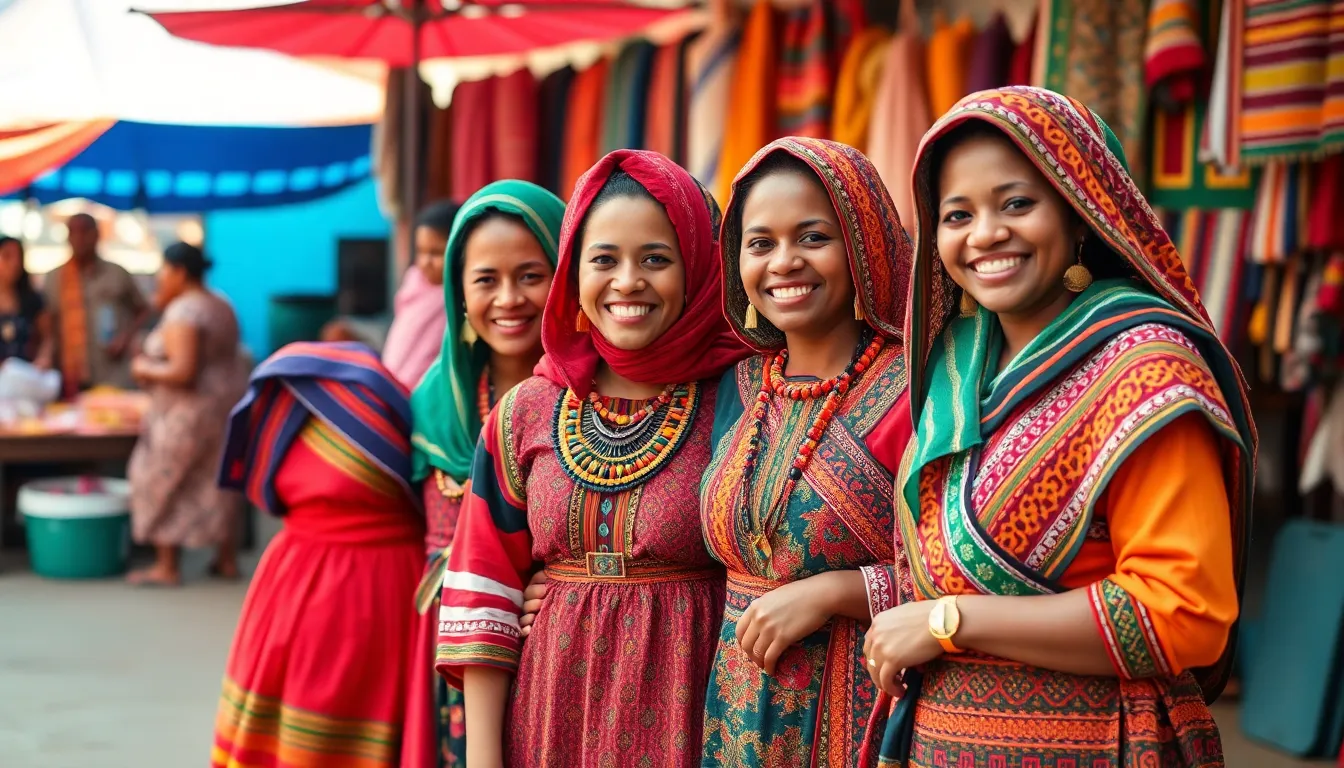Ethiopian cultural dress is more than just fabric; it’s a vibrant tapestry of history, tradition, and identity that’s sure to turn heads. Picture this: colorful patterns, intricate designs, and a flair that would make even a peacock jealous. Each piece tells a story, weaving together the rich heritage of a nation that’s as diverse as its landscapes.
Table of Contents
ToggleOverview of Ethiopian Cultural Dress
Ethiopian cultural dress showcases a rich tapestry of vibrant colors, intricate patterns, and symbolic designs. Traditional garments vary by region and ethnicity, reflecting the diverse cultural heritage of the nation. Clothing items, like the habesha kemis for women and the netela for both genders, highlight unique regional identities.
The habesha kemis features beautiful embroidery, often seen during festive occasions and celebrations. This ankle-length dress comes in various colors, frequently displaying intricate designs signifying cultural significance. Meanwhile, the netela, a lightweight shawl, serves multiple purposes, from providing warmth to enhancing traditional outfits.
Men commonly wear clothing such as the gabi and the kuta. The gabi, a heavy white cotton wrap, is often adorned with colorful borders or patterns. It provides comfort and versatility, suited for daily wear or special events. The kuta, designed with vibrant colors and geometric patterns, is a shirt worn in various styles.
Accessories play an essential role in Ethiopian attire. Jewelry, including beaded necklaces and silver rings, complements traditional outfits. Each piece carries historical significance, showcasing local craftsmanship and artistry.
Ethiopian cultural dress also adapts to modern influences while maintaining traditional elements. Many younger generations embrace contemporary styles, blending modern fashion with traditional motifs. This fusion captures the evolving identity of Ethiopia’s cultural expression.
Through its clothing, Ethiopia tells stories of unity, diversity, and cultural pride. The richness of Ethiopian dress serves as a visual representation of the country’s heritage, revealing how clothing unites communities and transcends generations.
Significance of Traditional Attire

Traditional Ethiopian attire signifies rich cultural narratives. Each garment embodies meaning through its designs and colors, often rooted in history and social status.
Symbolism in Fabrics and Colors
Fabrics used in Ethiopian clothing convey specific messages. Cotton remains a primary choice due to its comfort and breathability. White, often associated with purity, frequently features in many garments. Red symbolizes the struggle for freedom, while green represents hope and fertility. Patterns reflect regional identities, showcasing intricate designs. Accessories complement these fabrics, further enhancing their symbolism. Each color and fabric choice expresses individual narratives and cultural beliefs.
Regional Variations in Design
Ethiopia’s diverse regions showcase distinct clothing styles. The habesha kemis, prevalent in the central highlands, combines elegance and cultural pride. In contrast, the gabi worn in the northern regions highlights practicality and warmth. The Somali dress, known as the dirac, incorporates bright patterns unique to their culture. These designs differ across communities, illustrating the rich tapestry of Ethiopian heritage. Local customs influence variations, ensuring that traditional attire remains vibrant and relevant. Each design serves as a reminder of the nation’s unity amid diversity.
Key Types of Ethiopian Cultural Dress
Ethiopian cultural dress encompasses a variety of traditional garments that reflect the nation’s rich heritage. Each piece serves a unique purpose and holds cultural significance.
Habesha Kemis for Women
The habesha kemis stands out as an iconic garment for women, characterized by its elegant embroidery and intricate designs. Typically made from cotton, this dress comes in white, symbolizing purity. Women wear the habesha kemis during festive occasions, weddings, and religious ceremonies. Patterns can vary based on region, adding to its uniqueness. Some embellishments feature colorful threads representing different cultural backgrounds, linking women to their heritage.
Netela and its Cultural Importance
The netela serves as a versatile shawl, common among both men and women. Made from lightweight cotton, this garment can serve various purposes, from warmth to fashion accessory. Often draped over the shoulders, the netela showcases intricate patterns, weaving stories of tradition. It plays a crucial role during significant events and daily life, symbolizing community and identity. Different regions offer unique motifs in their netela designs, highlighting the rich diversity within Ethiopian culture.
Men’s Attire: Kilt and Shamma
Men’s traditional attire encompasses garments like the kilt and shamma, which are integral to Ethiopian cultural expression. The kilt typically features bright colors and geometric patterns, making it visually striking. Commonly worn during celebrations, it signifies cultural pride and unity. The shamma, a heavy cotton wrap, often comes with colorful borders and serves practical purposes during daily activities. Both garments not only represent style but also embody cultural narratives, connecting men to their roots and history.
Modern Adaptations of Ethiopian Fashion
Modern adaptations of Ethiopian fashion showcase a unique blend of tradition and contemporary aesthetics. This evolution reflects the dynamism of Ethiopian culture.
Fusion with Contemporary Styles
Fusion with contemporary styles marks a significant shift among younger generations. Designers often incorporate traditional motifs into modern silhouettes, creating outfits suitable for everyday wear. Symbolic patterns from the habesha kemis frequently appear on skirts, jackets, and casual dresses. Tailored garments, such as fitted dresses adorned with intricate embroidery, maintain cultural significance while appealing to modern tastes. Accessories also evolve, with traditional jewelry being reimagined in minimalist designs, attracting a broader audience. By merging past and present, Ethiopian fashion remains relevant and vibrant.
Influence on Global Fashion
Influence on global fashion highlights Ethiopia’s rich cultural heritage. International designers increasingly draw inspiration from Ethiopian textiles and designs, integrating these elements into their collections. Fashion shows in major cities showcase vibrant colors and intricate patterns rooted in Ethiopian traditions. Social media amplifies this trend, with influencers sharing styles that celebrate Ethiopian identity, reaching diverse audiences. Collaborations between Ethiopian artisans and foreign brands also enhance visibility, promoting sustainable practices in fashion. This cross-cultural exchange enriches the global fashion landscape, emphasizing Ethiopia’s unique contributions.
Ethiopian cultural dress stands as a powerful testament to the nation’s rich heritage and evolving identity. Each garment tells a unique story that resonates with both tradition and modernity. As younger generations embrace and reinterpret these styles, they ensure that the vibrant essence of Ethiopian attire continues to thrive.
This blend of old and new not only enriches the local fashion scene but also elevates Ethiopia’s presence on the global stage. Through fashion shows and social media, the world is discovering the beauty and significance of Ethiopian textiles. Ultimately, these garments serve as a bridge connecting past and present, fostering cultural pride and unity among communities.





